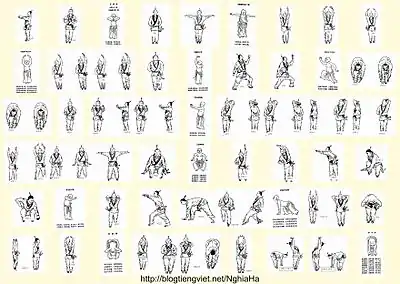Yijin Jing
The Yijin Jing (simplified Chinese: 易筋经; traditional Chinese: 易筋經; pinyin: Yìjīn Jīng; Wade–Giles: I Chin Ching; lit. 'Muscle/Tendon Change Classic') is a manual containing a series of exercises, coordinated with breathing, intended to dramatically enhance physical health when practiced consistently. In Chinese, yi means "change", jin means "tendons and sinews", while jing translates to "methods".

While some consider these exercises as a form of Qigong, the Yijin Jing contains a relatively intense set of practices that aim to strengthen muscles and tendons, promote strength and flexibility, increase speed and stamina, and improve balance and coordination of the body. These exercises are notable for their incorporation as key elements of the physical conditioning used in Shaolin training.
In the modern day, many translations and distinct sets of exercises are derived from the original (the provenance of which is the subject of some debate).
See also
Notes
References
- Hu, William (1965). "The I-Chin Ching, Fact or Fancy?". Black Belt Magazine. Black Belt Inc. (November 1965, Vol. III, No. 11): 28–30.
- Hu, William (1965). "Research Refutes Indian Origin of I-Chin Ching". Black Belt Magazine. Black Belt Inc. (December 1965, Vol. III, No. 12): 48–50.
- Matsuda, Ryuchi (1986). Zhōngguó Wǔshù Shǐlüè 中國武術史略 (in Chinese). Taipei: Danqing tushu.
- Shahar, Meir (2008). The Shaolin Monastery: History, Religion, and the Chinese Martial Arts. University of Hawaii Press. ISBN 978-0-8248-3110-3. Retrieved 2010-05-09.
